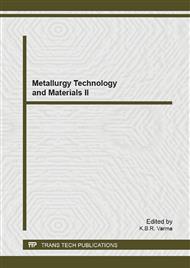p.351
p.355
p.359
p.364
p.372
p.377
p.382
p.387
p.391
Investigate the Characteristics of 0.65(K0.5Bi0.5TiO3)-0.35BaTiO3 Films at Various Deposition Temperatures
Abstract:
0.65(K0.5Bi0.5)TiO30.35BaTiO3 (KBT-BT3) ceramics were synthesized using a two-step calcination process that combined hydrothermal and conventional calcination processes. After sintered into ceramic target, KBT-BT3 films were deposited on Pt/Ti/Si and SiO2/Si/Al substrates by radio frequency magnetron (RF) sputtering at various temperatures. The surface morphologies and thicknesses of KBT-BT3 films were characterized by field emission scanning electron microscopy, and the thickness increased with increasing deposition temperature. XRD patterns showed that all KBT-BT3 films were amorphous and higher deposition temperature had no apparent effects to improve the crystalline orientation. The effects of deposition temperatures on the properties of the current-electric filed, polarization-applied electric field, and capacitance-voltage curves were also investigated. As deposition temperatures of KBT-BT3 films increased from room temperature to 400°C, the leakage current density had no apparent variation but the threshold voltage was shifted to lower value. The theorems for the effects of deposition temperature on the properties of KBT-BT3 films were also investigated.
Info:
Periodical:
Pages:
372-376
Citation:
Online since:
September 2013
Authors:
Keywords:
Price:
Сopyright:
© 2013 Trans Tech Publications Ltd. All Rights Reserved
Share:
Citation:


